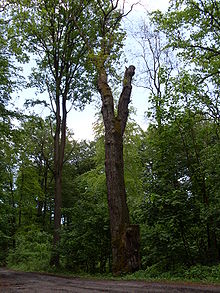
Back نصب تذكاري طبيعي Arabic Monumentu natural AST Тәбиғәт ҡомартҡыһы Bashkir Помнікі прыроды Byelorussian Помнік прыроды BE-X-OLD Природна забележителност Bulgarian Spomenik prirode BS Monument natural Catalan Přírodní památka Czech Naturmonument Danish


A natural monument is a natural or cultural feature of outstanding or unique value because of its inherent rarity, representative of aesthetic qualities, or cultural significance.[1] They can be natural geological and geographical features such as waterfalls, cliffs, craters, fossil, sand dunes, rock forms, valleys and coral reefs. Locations important to faith groups may be considered natural monuments. Archeological and historical sites linked to the natural environment are also included, such as cave art.[2] This is especially true when relevant to the land of Indigenous Peoples.
- ^ "natural monument — European Environment Agency". www.eea.europa.eu. Retrieved 2023-11-17.
- ^ Konyn, Carol (2021-07-06). "What are Natural Monuments?". Earth.Org. Retrieved 2023-11-17.